Grouping in WPF PropertyGrid
7 May 20219 minutes to read
We can combine the properties and club them into expandable groups according to our needs by Category attribute and Display.GroupName field. By default, the grouped properties are displayed in sorted view. If we want to display the property in grouped view, we can set the EnableGrouping property to true.

Grouping using attributes
Properties in the PropertyGrid will be grouped based on the name specified in the Category attribute and GroupName field of the Display attribute. If the property item doesn’t have any category name, that property will be grouped under Misc category.
using System;
using System.ComponentModel;
public class Employee {
[Category("Basic Info")]
public string ID { get; set; }
[Display(GroupName = "Basic Info")]
public string Name { get; set; }
[Display(GroupName = "Additional Info")]
public int Experience { get; set; }
[Category()]
public int Age { get; set; }
public DateTime DOB { get; set; }
}
public class ViewModel {
public Object SelectedEmployee { get; set; }
public ViewModel() {
SelectedEmployee = new Employee()
{
DOB = new DateTime(1995, 01, 31),
Name = "Johnson",
Experience = 5,
ID = "895",
Age = 25,
};
}
}<syncfusion:PropertyGrid SelectedObject="{Binding SelectedEmployee}" EnableGrouping="True"
x:Name="propertyGrid1">
<syncfusion:PropertyGrid.DataContext>
<local:ViewModel></local:ViewModel>
</syncfusion:PropertyGrid.DataContext>
</syncfusion:PropertyGrid>PropertyGrid propertyGrid1 = new PropertyGrid();
propertyGrid1.DataContext = new ViewModel();
propertyGrid1.SetBinding(PropertyGrid.SelectedObjectProperty, new Binding("SelectedEmployee"));
propertyGrid1.EnableGrouping = true;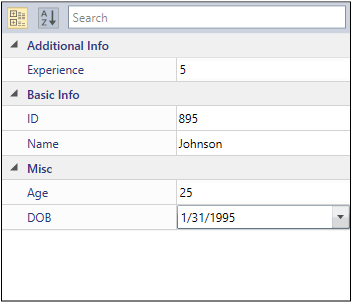
Here, ID, Name properties are grouped under the ‘Basic Info’ category and Experience property is grouped under ‘Additional Info’ category by using Category attribute or Display.GroupName field.
The Age and DOB properties do not contain any group name, so they are grouped under the Misc category.
NOTE
If we use both the
Categoryattribute andGroupNamefield of theDisplayattribute, theCategoryattribute will have higher priority.
Grouping the Properties at runtime
We can group the properties in the PropertyGrid without using the attributes at runtime by handling the AutoGeneratingPropertyGridItem event with AutoGeneratingPropertyGridItemEventArgs.Category property. Based on the value of Category property, the properties are grouped.
using System;
using System.ComponentModel;
using System.ComponentModel.DataAnnotations;
public class Employee {
public string Name { get; set; }
public string ID { get; set; }
public DateTime DOB { get; set; }
public int Experience { get; set; }
}
public class ViewModel {
public object SelectedEmployee { get; set; }
public ViewModel() {
SelectedEmployee = new Employee()
{
Name = "John",
ID = "381",
DOB = new DateTime(1995, 12, 24),
Experience = 5;
};
}
}<syncfusion:PropertyGrid AutoGeneratingPropertyGridItem="PropertyGrid1_AutoGeneratingPropertyGridItem"
EnableGrouping = "True"
SelectedObject="{Binding SelectedEmployee}"
x:Name="propertyGrid1">
<syncfusion:PropertyGrid.DataContext>
<local:ViewModel></local:ViewModel>
</syncfusion:PropertyGrid.DataContext>
</syncfusion:PropertyGrid>PropertyGrid propertyGrid1 = new PropertyGrid();
propertyGrid1.DataContext = new ViewModel();
propertyGrid1.SetBinding(PropertyGrid.SelectedObjectProperty, new Binding("SelectedEmployee"));
propertyGrid1.AutoGeneratingPropertyGridItem += PropertyGrid1_AutoGeneratingPropertyGridItem;
propertyGrid1.EnableGrouping= true;private void PropertyGrid1_AutoGeneratingPropertyGridItem(object sender, AutoGeneratingPropertyGridItemEventArgs e) {
//Experience and DOB properties grouped under 'Additional Info' category.
if (e.DisplayName == "Experience") {
e.Category = "Additional Info";
}
else if (e.DisplayName == "DOB") {
e.Category = "Additional Info";
}
//Name and ID properties grouped under 'Basic Info' category.
else if (e.DisplayName == "Name") {
e.Category = "Basic Info";
}
else if (e.DisplayName == "ID") {
e.Category = "Basic Info";
}
}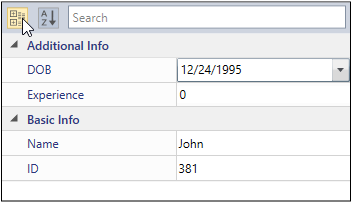
Here, the DOB and Experience properties are grouped under the Additional Info category and Name and ID properties are grouped under the Basic Info category
Click here to download the sample that showcases the property grouping support using AutoGeneratingPropertyGridItem event.
Expand or Collapse Category group
We can expand or collapse the grouped properties programmatically by using ExpandCategory and CollapseCategory methods in the PropertyGrid. These methods will accept group name as argument.
Expand Category group
ExpandCategory method will expand the specified category if it is in collapsed view.
//Expand the Identity category group
PropertyGrid propertyGrid = new PropertyGrid();
propertyGrid1.EnableGrouping= true;
propertyGrid1.ExpandCategory("Identity");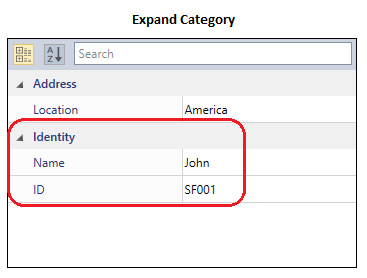
Collapse Category group
CollapseCategory method will collapse the specified category if it is in expand view.
//Collapse the Identity category group
PropertyGrid propertyGrid = new PropertyGrid();
propertyGrid1.EnableGrouping= true;
propertyGrid1.CollapseCategory("Identity");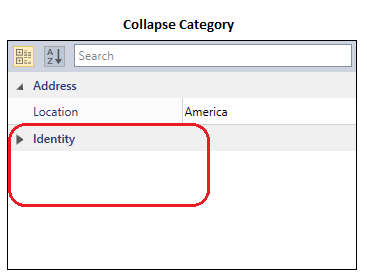
Show or Hide the Group Button
We can change the view of the properties from sorted view to grouped view by the GroupButton. We can show or hide the group button by using the ButtonPanelVisibility property. If we want to hide the GroupButton, set the ButtonPanelVisibility property as Collapsed. The Default value of the ButtonPanelVisibility property is Visible.
<syncfusion:PropertyGrid x:Name="propertyGrid1" Width="350" Height="400"
ButtonPanelVisibility="Collapsed">
<syncfusion:PropertyGrid.SelectedObject>
<Button></Button>
</syncfusion:PropertyGrid.SelectedObject>
</syncfusion:PropertyGrid>PropertyGrid propertyGrid = new PropertyGrid();
propertyGrid.Width = 350;
propertyGrid.Height = 400;propertyGrid.SelectedObject = new Button();
propertyGrid1.ButtonPanelVisibility = Visibility.Collapsed;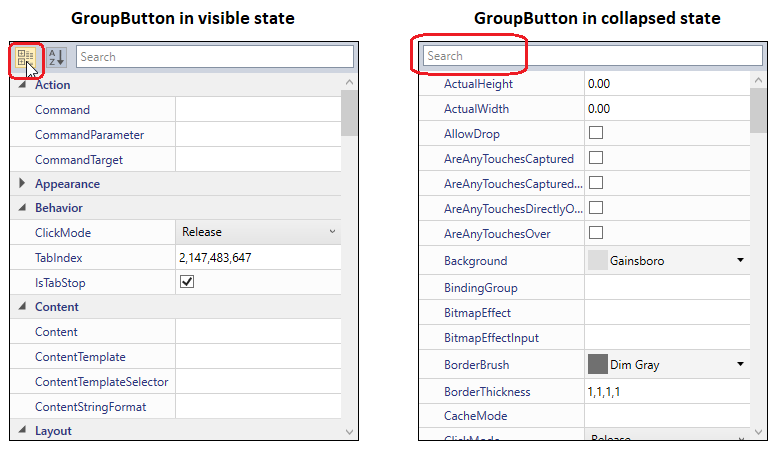
Click here to download the sample that showcases the property grouping support.